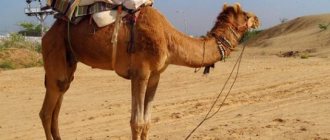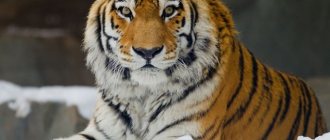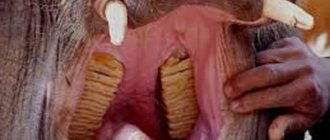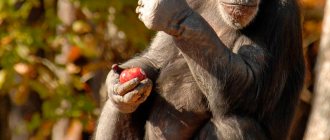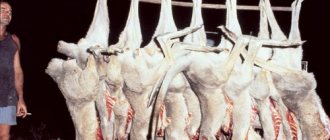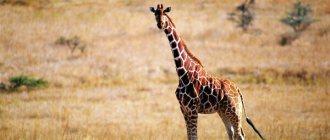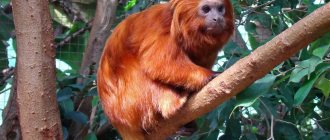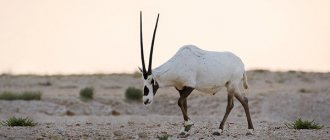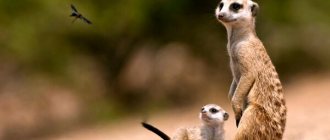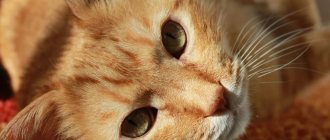- Wild animals
- >>
- Mammals
The interesting name wildebeest comes from its nasal moo. Even more interesting is the animal itself that makes such a sound. These are one of the most famous and curious animals in Africa; they seem to be made from several different animals and have retained the habits of each. They graze on flat terrain, but twice a year they go on a long journey in search of favorable conditions; this is a special event in wildlife.
Species and man
The history of the white-tailed wildebeest's relationship with humans is very instructive.
Unlike the blue wildebeest, which is widespread on the African continent, the white-tailed wildebeest had a small range in southernmost Africa, but was found there in abundance. Before the arrival of Europeans in Africa, the indigenous population hunted these antelopes for food, but this did not affect the total number of animals. However, by the 18th century the situation had changed radically. Since the establishment of the Cape Colony, Boer settlers considered the wildebeest and quagga a convenient source of food for their African workers. For more than 100 years, wildebeest were continuously persecuted, especially many animals were killed in the 70s of the 19th century by parties of skin hunters, who were then sent to Europe. By the end of 1885, researchers doubted whether even one animal remained in nature. Most likely, the white-tailed wildebeest would have suffered the same fate as the extinct quagga if not for the enthusiastic farmers who maintained a herd of 300 animals on their lands.
Over the next half century, all surviving animals were kept only on private farms. In 1936, several antelopes were released into a hunting reserve, where they successfully took root and began to breed. By the mid-20th century, the total number of white-tailed wildebeest reached 2 thousand. Currently, these animals live both in several protected areas and on private property.
All living white-tailed wildebeest are descendants of the 300 individuals that two South African farmers preserved on their lands in the late 19th century.
African buffalo
The largest representative of modern bulls. The height of the African buffalo at the withers reaches 1.8 m and the body length is 3-3.5 m. The weight of an adult male can be 900-1000 kg. The body of the buffalo is covered with sparse, coarse hair of black or dark gray color. The main decoration and weapon of African bulls is their powerful upward-curved horns. Despite its large build, the buffalo is very agile, sharp and fast - it can reach speeds of up to 57 km/h. African buffalo usually gather in small herds. In case of danger, the herd lines up in a semicircle - bulls on the outside, cows with calves in the middle. An adult buffalo can successfully fend off most predators, even alone.
The African buffalo is one of the most dangerous inhabitants of the African continent. More people die from these seemingly quiet and calm giants in Africa than from all the large cats combined. Sensing danger, the buffalo becomes irritable, aggressive and is capable of attacking both the animal and the person. Lions, for example, do not dare to enter into a fight with this bull, since they are very afraid for its outcome. And not in vain! With its blow, a buffalo is capable of overturning a loaded jeep along with hunters.
Appearance and morphology
Wildebeest are so unique that once you see this animal, you will always recognize it. The body is short and dense, with a sloping back. The head is large, heavy, with a long muzzle, covered with a brush of coarse hair sticking up. A beard under the throat, a tuft of hair between the front legs and a rough mane on the neck and withers. Horns are present in individuals of both sexes; they are smooth, fused at the base and intricately curved. The length of the horns through the apex of the bend reaches 70–80 cm. The tail is long, white, almost reaches the ground, well-furred and looks like a horse's. The legs are thin with sharp hooves. The body color of the white-tailed wildebeest is dark brown, the mane and beard are almost black, males are somewhat darker than females. The summer coat of animals of both sexes is lighter than the winter coat, and by winter a thick undercoat grows. Females are similar to males, but somewhat smaller, and their horns are thinner. The weight of white-tailed wildebeest is usually up to 160–180 kg, and the height at the withers is 115–120 cm.
Zebra
It is a type of wild horse. The height of a male adult zebra is 1.2-1.4 m, body weight is 175-450 kg, tail length is more than 50 cm. Zebras have a characteristic black and white striped color. The skin of this animal is very smooth, so the stripes appear painted on. Zebras behave like typical inhabitants of open spaces. They move from pasture to pasture in large herds. In case of danger, the herd is gathered in such a way that the cubs are in the middle of it. Thanks to this, the predator has little chance of getting to the young animals that have not yet matured.
Lifestyle and social organization
Until the end of the 19th century, while there were many white-tailed wildebeest, no one studied them. What is known is that, like the blue wildebeest, they migrated in huge herds, and that they are more aggressive than this closely related species.
Currently, migrations of white-tailed wildebeest are not observed; apparently, with the presence of artificial watering places, the need for long-distance movements has disappeared. The size of the groups of these antelopes depends on the abundance of food. When there is an excess of it, female herds can number from 14 to 32 females, between whom a certain hierarchy is established. Unlike the more social species - blue wildebeest - white-tailed wildebeests never exhibit grooming, only sometimes one animal can rub its horns on the neck of another. An adult male stays with a group of females and drives away other males. The size of the area used by the group depends on the topography and vegetation and averages 100 hectares. During the dry season, when pastures are scarce, animals are more tolerant of each other.
Young animals stay with their mothers until the birth of younger brothers and sisters. Females may remain in the maternal group, but adults begin to pursue growing males, encouraging them to leave. Such exiles may wander alone for some time, becoming easy prey for predators, but then join the bachelor herds. There they spend time playing games with peers, measuring their strength with them, so when the time comes to acquire their own territory, the strongest have already been determined.
Hippopotamus
He's a hippopotamus. This is one of the largest land animals: the weight of large males can exceed 4 tons, and the body length can reach 5 m. Hippos spend the entire day in the water, and at nightfall they go to pasture. Hippopotamuses feed on semi-aquatic or terrestrial grass. At first glance, these animals seem calm, slow and clumsy. In reality, their behavior is completely unpredictable. Suddenly angry. a hippopotamus can quickly attack both a person and an elephant, destroying everything in its path.
Nutrition and feeding behavior
Wildebeest graze mainly in the morning and evening hours, but like all ungulates, there are several peaks of activity during the day. Animals rest in open places with good visibility.
The wide muzzle of the wildebeest is most suitable for plucking short green grass, and indeed, the animals eat mainly herbaceous plants. When reaching short grass, they sometimes kneel down. In winter, during the dry season, wildebeest eat sparse bushes. These animals need watering places throughout the year.
Natural enemies
Lions, hyenas, crocodiles, leopards and cheetahs are the main enemies of the wildebeest. Everything that remains after their feast is happily picked up by vultures.
Return to content
Reproduction and development
The seasonality of reproduction in wildebeest is well expressed. Mating occurs at the end of the rainy season, from February to April. At this time, the harem male is able to defend only a small area of his territory, as competitors try to approach the females from all sides. He does not sleep or eat, trying to keep females near him and driving away other males. At the same time, his energy expenditure is such that after a few days, weakened, he is either driven out by one of his competitors, or the females leave in search of food.
Cubs appear at the beginning of the wet season after 8–8.5 months of gestation. A female usually gives birth to one calf annually. Like the cubs of other antelopes, the newborn is already fully developed; after 15–20 minutes it stands on its legs, and after a few days it can already jump, doing funny little knees. The color of its fur is somewhat lighter than that of an adult animal, and its horns begin to grow after a few months. At one week of age, the baby already begins to move his lips and try to eat grass, but milk feeding continues for 8–9 months. The calf maintains a close connection with its mother throughout the year; sexual maturity occurs at the age of 2-2.5 years, but males are allowed to reproduce much later.
wild dog
This carnivorous representative of the canine family lives only on the African continent. It is sometimes called the African wild dog. This animal is easily recognized by its spotted fur of various colors - red, black, white, brown, yellow. The color of each wild dog is unique. This is an exceptionally hardy animal, capable of reaching speeds of more than 30 km/h over long distances. Typically, wild dogs gather in packs of 30 to 100 individuals. Acting in an organized manner, they are able to pursue large prey for a long time.
White-tailed wildebeest at the Moscow Zoo
Our zoo has kept wildebeest since 1992. You can see a group of these animals in the old territory next to the giraffe’s house, where they have a large clearing allotted to them. In the new territory, a single male wildebeest lives in the Ungulates of Africa pavilion.
Animals have access to an outdoor enclosure all year round; they are locked indoors only at night. These antelopes adapt well to cold weather and only come indoors during the day at temperatures below -20°. Unlike most tropical ungulates, white-tailed wildebeest have the ability to grow a thick, warm undercoat and shed profusely in the spring. If they are locked in a warm room for the winter, this leads to a number of health complications - wildebeest are susceptible to allergies to sawdust dust, which can cause asthmatic attacks in them. For pregnant females, the lack of active movement is fraught with complications during childbirth.
Wildebeest are fed twice a day, hay and branches are placed in outdoor feeders, and succulent food (carrots, beets and fruits) and concentrated food are given indoors. Zoo staff do not enter enclosures in the presence of animals, since the impulsiveness of animals, combined with sharp horns, makes them dangerous in a small confined space.
Wildebeest calves are born at the zoo almost every year in the summer, often right in front of visitors, since the mother in labor is not separated from the group. All adult wildebeests, a few minutes after giving birth, come up to greet the new member of the group, who in a few days will happily jump around his mother, making people smile.
